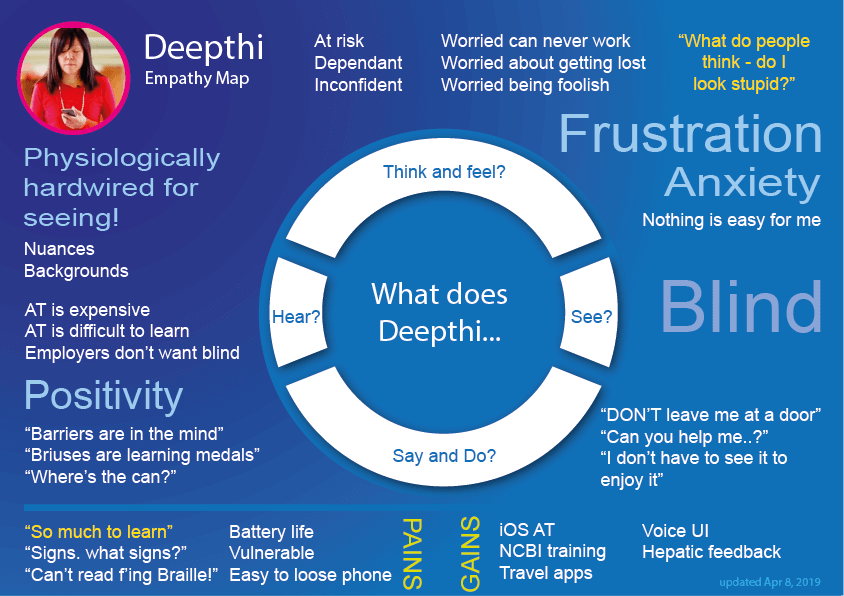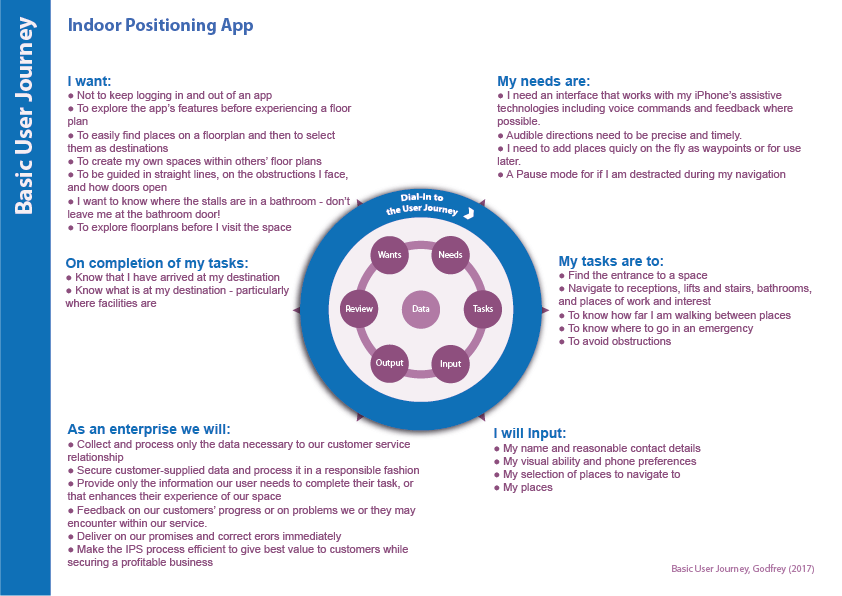| Objectives |
|---|
| Problem definition – problem statement, target users (personas/empathy maps), scenarios + storyboards – 100 words |
The Problem
GPS navigation is unreliable, of poor definition, or unavailable indoors. Indoor Positioning Systems (IPS) are available to map places, objects, and services (spots) on floor plans.
Systems may be inclusive and still fail to serve the needs of our visually impaired users. For example, traversing interactions using accessible adjuncts may delay actions or decisions and cause an injury or inconvenience. And how do blind people walk straight over distance?
Who are we designing for?
Our target user groups are:
| Priority | User Group |
|---|---|
| Primary | (Recently) blind |
| Secondary | Visually impaired |
| Tertiary | All other users |
Problem Statement
As a recently blinded person, I want to navigate my indoor spaces, so I can regain my independence.
Meet Deepthi
Deepthi is our primary proto-persona created from our user and situational research. (Open a text version of the persona).
Empathy Map
Based on the realm of recently blinded people, an empathy map visualises Deepthi’s perceptions of problems and opportunities. (Open a text version of the empathy map).
It’s one thing to identify the bathroom and another to find a free stall.
Affinity Diagram
After experiencing spaces blindfolded and listening to NCBI’s podcasts (NCBI, n.d.), we can list and catagorise an affinity with Deepthi. (Open a text version of the affinity diagram).
Scenarios
Combining our persona, empathy map, and affinity map, we can build a realistic “as is” customer journey map to illustrate a scenario we want to solve for Deepthi. (Open a text version of the customer journey map).


Basic User Journey
The Basic User Journey iteratively guides our application flow, features, and interactions; matching our enterprise resources to our users’ expectations. (Open a text version of the Basic User Journey).
Toward Solutions
With empathy and understanding of Deepthi’s goals and problems, we can make assumptions and prioritise goals over features. (See Figure 1.)
Goals vs Features
Deepthi’s goal is to navigate indoor spaces and save “spots” of her choosing.
Features should include:
- iOS accessibility.
- On demand connection to an IPS floor plan.
- A list of spots to navigate to.
- Start, Pause, and Stop controls.
- Audible directions and guidance.
- Descriptions of spots layout, facilities, amenities, and obstructions, etc.).
- Ability to save spots.
Assumptions
1. The spaces Deepthi visits have prepared their:
- IPS system and floor plans to Apple (2019) IMDF standards.
- Beacons and network.
- Walkways and routes.
- Places or points of interest (spots).
- Bluetooth security to work seamlessly with the application.
2. Our Primary and Secondary user groups are familiar with iOS accessibility adjuncts. Therefore:
- An iOS application interface is familiar and accessible.
- New features should be minimised.
3. Art direction is for Tertiary sighted users, especially when asked to assist Primary and Secondary users.
- Learning must be minimised.
- The interactions minimal.
4. Our Primary users have limited financial means. The application must work on iPhone 5 and 6 and be free to use. (Host sites benefit from improved customer interfacing).




